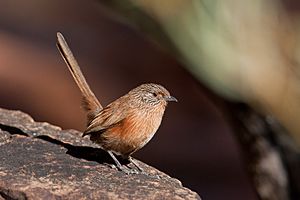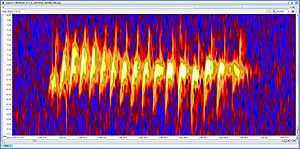Dusky grasswren facts for kids
Quick facts for kids Dusky grasswren |
|
|---|---|
 |
|
| Conservation status | |
| Scientific classification | |
| Genus: |
Amytornis
|
| Species: |
purnelli
|
The dusky grasswren (Amytornis purnelli) is a small passerine bird that lives only in Australia. You can find it in the dry, inland parts of the Northern Territory, Western Australia, and South Australia. It belongs to the Maluridae family, which also includes the well-known fairywrens.
Contents
What Does the Dusky Grasswren Look Like?
The dusky grasswren looks a lot like other grasswrens. But it's special because it's the only one that lives only in the rocky mountain ranges of Central Australia.
This bird is mostly brown. It has thin, pale stripes on its head, chest, and back. Its back is a richer, reddish-brown, and its belly is light, almost a creamy color.
The easiest way to tell males and females apart is that adult females have a bright, rusty-brown spot on their sides. All dusky grasswrens, like other birds in their family, hold their tails pointing upwards.
How to Spot a Dusky Grasswren in the Wild
It can be tricky to see these birds clearly. They move like mice and stay close to the ground. They prefer rocky hillsides covered with spiky spinifex grasses.
However, you can often identify them by their unique calls. If you do get a good look, their upward-pointing tail, brown color, and ground-dwelling habits will help you know it's a dusky grasswren.
Birds That Look Similar
The dusky grasswren looks similar to other grasswrens in its group. But it's usually easy to tell apart if you see it well. It probably doesn't share its exact habitat with other grasswren species. Its calls are also different.
Some birds that might cause confusion are the Kalkadoon grasswren (Amytornis ballarae) and the thick-billed grasswren (Amytornis modestus). The Kalkadoon grasswren lives far to the northeast. The thick-billed grasswren is thought to be gone from the Northern Territory and lives only to the south and east in South Australia.
You might also confuse it with the striated grasswren (A. striatus). But the dusky grasswren doesn't live in the sandy areas where the striated grasswren is found. Also, the striated grasswren has much bolder markings, making it easy to tell apart.
Fairywrens, like the Splendid fairywren (Malurus splendens), Purple-backed fairywren (M. assimilis), and White-winged fairywren (M. leucopterus), live in the same areas. They might sound similar in their short contact calls. But if you hear their full songs, they are easy to tell apart. Fairywrens are usually grey (except for breeding males, which have bright colors) and have blue on their tails.
What Sounds Do They Make?
Dusky grasswrens often first show themselves with a sharp, metallic "tutting" sound when they are alarmed. They also make a long "seeeep" sound to keep in touch with each other.
They have many different calls, including trills, high-pitched whistles, fast chirps, and quick warbling. Many of their calls are so fast that it's hard for humans to hear all the details. But if recordings are slowed down, you can hear how rich and varied their calls are.
Differences in Different Areas
Birds from different parts of the dusky grasswren's range can look and sound a bit different. For example, birds in the north of their range have louder, sharper calls. They also tend to be paler in color. Birds in the south are a richer reddish-brown. Scientists are still studying if these differences are big enough to make them separate types of birds.
Where Do Dusky Grasswrens Live and What Do They Eat?
Their Home (Habitat)
Dusky grasswrens always live in the same kind of place. They like rocky ranges and outcrops, especially areas with piles of loose rocks. These places must also have thick, old spinifex grasses (from the Triodia group). They don't seem to use sandy areas next to the rocks. This might be why they are found in patches across Central Australia.
What Do They Eat?
In the wild, dusky grasswrens eat small insects and other tiny creatures. They also eat seeds and small desert fruits. There aren't many detailed reports of them feeding in the wild.
In zoos, they eat a mix of meat, greens, and vegetables. They also get live insects like cockroaches and mealworms.
Dusky Grasswrens in Zoos
The Alice Springs Desert Park has successfully kept dusky grasswrens since 2009. They have also managed to breed them and release some back into the wild.
Where Are Dusky Grasswrens Found?
Most of the areas where dusky grasswrens live are very remote. Not many people visit them regularly. Because of this, we don't know much about their exact distribution. Even though their range looks big on a map, they might only live in small, scattered groups within it.
The northernmost records are from the Ashburton Range in the Northern Territory. The southernmost are in the Musgrave, Mann, and Tomkinson Ranges of South Australia. They have been seen as far west as the Schwern-Mural Crescent in Western Australia and as far east as the Davenport and Murchison Ranges in the Northern Territory. There are huge areas of unsuitable habitat that separate these groups of birds.
How Are Dusky Grasswrens Protected?
The dusky grasswren is not considered an endangered species. This is mainly because it lives across a very large area. Even though we don't have exact numbers for their population, scientists believe they have a stable population. So, they are not currently at risk of becoming endangered.
What Are the Dangers to Them?
There are no official reports of introduced predators like cats and foxes eating dusky grasswrens. However, other grasswren species have been found in the stomachs of wild cats. So, it's likely that cats and foxes do hunt them.
There are also no official studies on how fires affect these birds. But many people who observe them say it can take decades for the birds to return to an area after a fire. If this is true, then changes in how fires are managed and the growth of invasive weeds could become serious threats to them.
Dusky Grasswrens and People
Because they are hard to find and live in remote places, grasswrens have many fans among birdwatchers and scientists worldwide. Most grasswrens are very difficult to spot and even harder to watch closely.
The dusky grasswren is special because it's the only one you can see in captivity. It also has a reputation for being one of the easier grasswrens to see in the wild. You can find healthy numbers of them in the MacDonnell Range, which is close to the town of Alice Springs in the Northern Territory. Many people have seen and photographed them there.
Indigenous Knowledge About the Bird
The dusky grasswren lives in the traditional lands of many Indigenous peoples in central Australia. It's not known by one specific name in all central Australian languages. Instead, it might be called by names that are used for several small bird species.
For example, it might be called mirilyirilyi in Pitjantjatjara/Yankunytjatjara. In Warlpiri, it might be jiwilyirrilyirri. And in Anmatyerre and Arrernte, it could be lyerr-lyerr. However, these names are also used for fairywrens.
Some Indigenous names that might specifically refer to the dusky grasswren or striated grasswren are antyarlkarleny from Alyawarre, ntyalkarlenye from Kaytetye, and tjinytjirlirlin(pa) from Ngaanyatjarra/Ngaatjatjarra.
See also
 In Spanish: Maluro sombrío para niños
In Spanish: Maluro sombrío para niños





